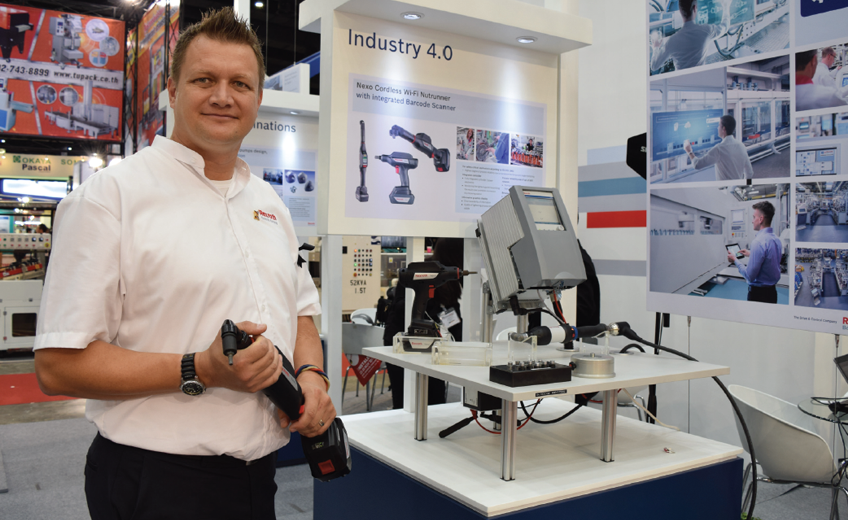Industry 4.0 is a buzzword being floated as a modernizing force in manufacturing. But the term induces unease in those who fear the replacement of workers by smart robots. Lars Langner, general manager of Bosch Rexroth (Thailand), a subsidiary of Robert Bosch Co Ltd, sees it as an opportunity.
“Most people simply think that Industry 4.0 is just about replacing humans with robots and everything will be better,” he said. “For us, Industry 4.0 is about getting the right information to the right people and enabling them to make the right decision.”
Mr Langner in a discussion with Elite+ showed computer monitors detailing work processes and information and data from the manufacturing process. He oversees sales and service plant located at Amata City Industrial Estate in Rayong Province. Bosch, a German company selling manufacturing technology and machinery, opened a production base in Thailand 25 years ago. Bosch sells manufacturing technology and automation for packaging, food production and automotive supplies, and many more.
.png)
According to Mr Langner, Industry 4.0 is about connecting humans with machines via information technology. “It is about connecting devices, getting data from various production points, analysing data and making the right decision, because our background is manufacturing. We need this kind of visualization, we need this kind of work process and detail transparency to make our manufacturing technology more productive, more creative and thus more competitive.”
An example of manufacturing technology created by Bosch Rexroth is the “modular assembly line”, which last June won the MaschinenMarkt Award for innovation from an inflfl uential German trade magazine.
According to the company website, the modular assembly line shows how manufacturers can benefifit from computerizing the manufacturing process. A connected intelligent assembly line helps users visualize workflflow and analyse production data, thus improving productivity and eliminating ineffificient processes.
For example, in fifi ve modular stations on the line, there are applications of a heat-conducting paste, mounting, screw tightening, manual assembly and a test station. The assembly line connects machines with workstations for people. The connected system can send data on operating conditions to higher-level systems. This is cheaper than building a new system and lowers the barrier to implementing Industry 4.0.
Mr Langer has good reason to be proud of German technology as it applies to Industry 4.0. Indeed, the term was proposed in 2011 at the Hanover Fair and adopted by the German government in 2013. The concept refers to the history of industrialization as four phases – 1.0 being machination by steam power, 2.0 mass production by factory assembly lines powered by electricity, 3.0 computer and automation while 4.0 involves bringing intelligence, connectivity and broader computerization to manufacturing.
The Thai government is intent on upgrading to Industry 4.0 despite questions about Thailand’s readiness. One critic is Khanitha Hongprayoon, a researcher at the Thailand Development Research Institute (TDRI). The industry policy analyst in the Bangkok Post last year warned that the Thai government and public sector must fifirst create a skilled workforce in order to harness Industry 4.0.
Federation of Thai Industries chairman Chen Namchaisiri told The Nation that most local manufacturers belong to the 2.0 or 2.5 eras and should fifi rst be upgraded to 3.0 through automation, and only some are ready for 4.0.
According to National Statistical Offifi ce data surveyed in the third quarter of 2016, 40.1% of the Thai industrial workforce has only a primary school education or less. Workers with degrees in science, engineering, mathematics and computer science represent only 10.4% of the labour market. Last June, Prime Minister Prayut Chan-o-cha insisted the country faced a shortage of engineers, particularly in the hi-tech sector. Thailand has less than 50% of the engineers it needs for this sector.
In a ranking of 138 countries, the 2016-2017 Global Competitiveness Report places Thailand 63rd in technological readiness and 54th in innovation. The total score in each pillar is below average in the Asia-Pacififi c region.
Mr Langer, however, believes Thailand can adapt to 4.0. “Thailand on average is quite young and new to adapt to new technology compared to Europe, which is more familiar with old fashioned technology. However, manufacturers, academic institutes and vocational colleges must quickly prepare human resources to be ready. The key to 4.0 is education. It is all about using information smartly. You need to have educated staff and you need to provide them with training because in industry 4.0, you need to use software.”
Mr Langer emphasized that creating skilled labour for Industry 4.0 will need a holistic approach. It is not enough for workers to become experts in a single area. Workers need to know about technology and related sciences such as engineering and information technology. “Only constructing something is no longer enough for Industry 4.0.”
The only industries to have adopted Industry 4.0 so far are the automotive, packaging and sugar industries. Thai authorities have not sat by idly, however. The Ministry of Industry recently formed the Industrial Transformation Centre, which offers help to manufacturers wanting to upgrade their manufacturing. The ministry recently opened the Industrial Design Centre to provide design consultancy to manufacturers.
The government is collaborating with the Thai Chamber of Commerce and University of the Thai Chamber of Commerce to help small and medium-sized enterprises and create a new breed of entrepreneurs with the necessary skill set for Industry 4.0.




























































































































































































































































































































































































































































































































































































































































































































































































































































































































